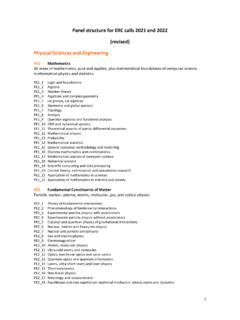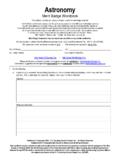Transcription of SOME A PPLICATIONS OF TRIGONOMETRY - NCERT
1 SOME APPLICATIONS OF IntroductionIn the previous chapter, you have studied about trigonometric ratios. In this chapter,you will be studying about some ways in which TRIGONOMETRY is used in the life aroundyou. TRIGONOMETRY is one of the most ancient subjects studied by scholars all over theworld. As we have said in Chapter 8, TRIGONOMETRY was invented because its needarose in astronomy . Since then the astronomers have used it, for instance, to calculatedistances from the Earth to the planets and stars. TRIGONOMETRY is also used in geographyand in navigation. The knowledge of TRIGONOMETRY is used to construct maps, determinethe position of an island in relation to the longitudes and have used TRIGONOMETRY forcenturies.
2 One such large surveying projectof the nineteenth century was the GreatTrigonometric Survey of British Indiafor which the two largest-ever theodoliteswere built. During the survey in 1852, thehighest mountain in the world wasdiscovered. From a distance of over160 km, the peak was observed from sixdifferent stations. In 1856, this peak wasnamed after Sir George Everest, who hadcommissioned and first used the gianttheodolites (see the figure alongside). Thetheodolites are now on display in theMuseum of the Survey of India APPLICATIONS OFTRIGONOMETRYA Theodolite(Surveying instrument, which is basedon the Principles of TRIGONOMETRY , isused for measuring angles with arotating telescope) NCERT not to be republished196 MATHEMATICSIn this chapter, we will see how TRIGONOMETRY is used for finding the heights anddistances of various objects, without actually measuring Heights and DistancesLet us consider Fig.
3 Of prvious chapter, which is redrawn below in Fig. this figure, the line AC drawn from the eye of the student to the top of theminar is called the line of sight. The student is looking at the top of the minar. Theangle BAC, so formed by the line of sight with the horizontal, is called the angle ofelevation of the top of the minar from the eye of the , the line of sight is the line drawn from the eye of an observer to the pointin the object viewed by the observer. The angle of elevation of the point viewed isthe angle formed by the line of sight with the horizontal when the point being viewed isabove the horizontal level, , the case when we raise our head to look at the object(see Fig.)
4 Fig. NCERT not to be republishedSOME APPLICATIONS OF TRIGONOMETRY197 Now, consider the situation given in Fig. The girl sitting on the balcony islooking down at a flower pot placed on a stair of the temple. In this case, the line ofsight is below the horizontal level. The angle so formed by the line of sight with thehorizontal is called the angle of , the angle of depression of a point on the object being viewed is the angleformed by the line of sight with the horizontal when the point is below the horizontallevel, , the case when we lower our head to look at the point being viewed(see Fig.)
5 Fig. , you may identify the lines of sight, and the angles so formed in Fig. they angles of elevation or angles of depression?Let us refer to Fig. again. If you want to find the height CD of the minarwithout actually measuring it, what information do you need? You would need to knowthe following:(i) the distance DE at which the student is standing from the foot of the minar(ii)the angle of elevation, BAC, of the top of the minar(iii)the height AE of the that the above three conditions are known, how can we determine theheight of the minar?In the figure, CD = CB + BD. Here, BD = AE, which is the height of the find BC, we will use trigonometric ratios of BAC or ABC, the side BC is the opposite side in relation to the known A.
6 Now,which of the trigonometric ratios can we use? Which one of them has the two valuesthat we have and the one we need to determine? Our search narrows down to usingeither tan A or cot A, as these ratios involve AB and BC. NCERT not to be republished198 MATHEMATICST herefore,tan A = BCABor cot A = AB,BC which on solving would give us adding AE to BC, you will get the height of the let us explain the process, we have just discussed, by solving some 1 : A tower stands vertically on the ground. From a point on the ground,which is 15 m away from the foot of the tower, the angle of elevation of the top of thetower is found to be 60.
7 Find the height of the : First let us draw a simple diagram torepresent the problem (see Fig. ). Here ABrepresents the tower, CB is the distance of the pointfrom the tower and ACB is the angle of need to determine the height of the tower, ,AB. Also, ACB is a triangle, right -angled at solve the problem, we choose the trigonometricratio tan 60 (or cot 60 ), as the ratio involves ABand ,tan 60 = ,3 = ,AB =15 3 Hence, the height of the tower is 15 3 2 : An electrician has to repair an electricfault on a pole of height 5 m. She needs to reach apoint below the top of the pole to undertake therepair work (see Fig.)
8 What should be the lengthof the ladder that she should use which, when inclinedat an angle of 60 to the horizontal, would enable herto reach the required position? Also, how far fromthe foot of the pole should she place the foot of theladder? (You may take 3 = )Fig. NCERT not to be republishedSOME APPLICATIONS OF TRIGONOMETRY199 Solution : In Fig. , the electrician is required to reach the point B on the pole , BD = AD AB = (5 )m = , BC represents the ladder. We need to find its length, , the hypotenuse of theright triangle , can you think which trigonometic ratio should we consider?
9 It should be sin 60 .So,BDBC = sin 60 = 32 Therefore,BC = = m (approx.) , the length of the ladder should be ,DCBD = cot 60 = ,DC = = m (approx.)Therefore, she should place the foot of the ladder at a distance of m from 3 : An observer m tall is m awayfrom a chimney. The angle of elevation of the top ofthe chimney from her eyes is 45 . What is the heightof the chimney?Solution : Here, AB is the chimney, CD the observerand ADE the angle of elevation (see Fig. ). Inthis case, ADE is a triangle, right- angled at E andwe are required to find the height of the haveAB = AE + BE = AE + = CB = mTo determine AE, we choose a trigonometric ratio, which involves both AE andDE.
10 Let us choose the tangent of the angle of NCERT not to be republished200 MATHEMATICSNow,tan 45 = ,1 =AE28 .5 Therefore,AE = the height of the chimney (AB) = ( + ) m = 30 4 : From a point P on the ground the angle of elevation of the top of a 10 mtall building is 30 . A flag is hoisted at the top of the building and the angle of elevationof the top of the flagstaff from P is 45 . Find the length of the flagstaff and thedistance of the building from the point P. (You may take 3 = )Solution : In Fig. , AB denotes the height of the building, BD the flagstaff and Pthe given point.















